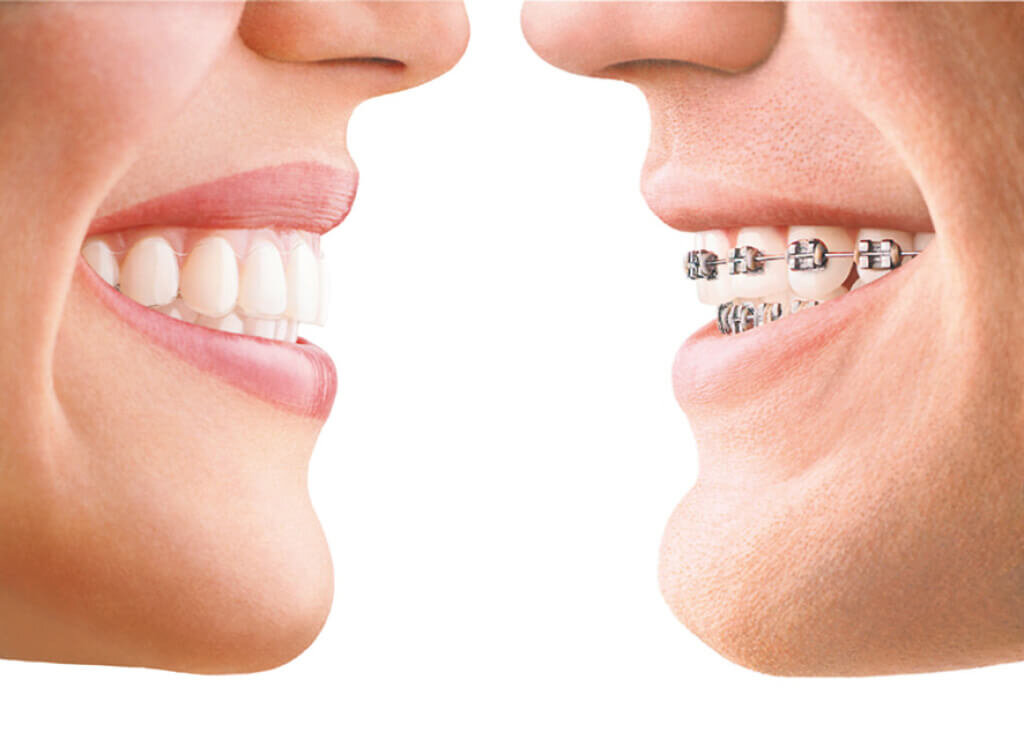Invisalign vs. Typical Braces: Which Option Is Right for You?
When considering orthodontic therapy, the selection in between Invisalign and typical braces offers numerous crucial aspects that warrant mindful evaluation. Invisalign offers a discreet choice with detachable aligners, while conventional dental braces give a much more noticeable yet effective option for extreme misalignment.
Summary of Therapy Choices
&srotate=0)
In comparison, standard dental braces contain steel brackets and cables that are bound to the teeth. This method applies continual stress in time to accomplish positioning. While efficient for complex orthodontic issues, conventional dental braces require regular check outs for changes and can posture difficulties in preserving dental health due to the difficulty of cleaning about brackets and cords.
Both choices have their qualities, and the selection commonly depends upon certain oral conditions, way of living choices, and person conformity. Ultimately, speaking with an orthodontic specialist is critical for identifying one of the most ideal treatment plan customized to individual requirements. Recognizing the nuances of each choice can significantly affect the general success of orthodontic treatment.
Visual Factors To Consider
A substantial aspect influencing the selection between Invisalign and traditional braces is the aesthetic charm each therapy supplies. Invisalign aligners are crafted from clear plastic, making them essentially unseen when used.
In comparison, conventional dental braces include metal brackets and wires, which can be more recognizable. While advancements in orthodontic innovation have caused the advancement of smaller brackets and colored elastics, conventional braces still maintain an even more obvious account. For some people, the visibility of dental braces might prevent them from seeking required therapy.
Eventually, the option between Invisalign and conventional dental braces might hinge on personal preferences pertaining to visual appeals. Patients that focus on discernment usually favor Invisalign, while those that are much less worried about presence may opt for conventional dental braces. Recognizing the aesthetic ramifications of each choice is essential for making a notified choice that straightens with one's way of living and preferences.
Comfort and Convenience

In terms of convenience, Invisalign aligners are detachable, making it possible for people to appreciate their favorite foods without constraint and maintain ideal dental health. Cleaning and flossing are simplified, as the aligners can be obtained during these regimens, whereas typical braces call for cautious steering around wires and braces.
In contrast, standard dental braces necessitate routine modifications, making them much less hassle-free for those with hectic schedules. On the whole, the convenience and benefit of Invisalign make it an enticing choice for many individuals looking for orthodontic treatment.
Therapy Duration and Efficiency
While both Invisalign and typical dental braces work in fixing oral misalignments, the duration of treatment can differ considerably between the 2 alternatives. Commonly, Invisalign treatment can take anywhere from 12 to 18 months, depending upon the complexity of the instance. The clear aligners function by progressively changing teeth into their desired settings, and regular follow-ups with an orthodontist aid make sure progress remains on the right track.
In contrast, typical braces commonly require a longer dedication, typically varying from 18 months to 3 years. This is because of their fixed nature and using brackets and cables, which can be much more reliable for complicated instances and extreme imbalances (Invisalign). The treatment effectiveness of traditional dental braces is well-documented, as they permit accurate adjustments and greater control over tooth activity
Eventually, the option in between Invisalign and standard braces may rest on both the anticipated therapy duration and the details dental issues at hand. Consulting with an orthodontist is crucial, as they can give customized referrals based upon individual requirements, ensuring the chosen method straightens with preferred timeframes and outcomes.
Cost Contrast and Insurance Choices
Expense plays a substantial role in the decision-making procedure for individuals considering orthodontic therapy, whether choosing Invisalign or traditional dental click for more braces. Usually, the price of Invisalign arrays from $3,000 to $8,000, while conventional braces her response generally cost in between $2,000 and $6,000. Elements influencing these costs include the complexity of the situation, the period of treatment, and geographical area.
Insurance protection can dramatically affect out-of-pocket expenses. Lots of oral insurance coverage strategies provide partial insurance coverage for orthodontic treatments, but the specifics can vary commonly. It is vital for people to evaluate their insurance coverage to identify the level of protection for either option. Typically, standard dental braces may be much more regularly covered by insurance policy strategies contrasted to Invisalign, which some insurance firms categorize as an aesthetic procedure.
Furthermore, several orthodontic practices offer adaptable layaway plan, making both therapy alternatives much more obtainable. Individuals ought to make inquiries about possible funding options and discounts for ahead of time repayments. Evaluating the total cost, including insurance policy advantages and payment plans, is essential for making an educated choice that lines up with both aesthetic preferences and budget factors to consider.

Verdict
In summary, the choice between Invisalign and typical dental braces depends upon numerous factors, including aesthetic preferences, comfort, therapy duration, and expense. Invisalign offers a very discreet, removable choice that promotes oral hygiene and dietary flexibility, while traditional braces might be extra appropriate for complicated oral concerns and typically come at a lower rate point. Inevitably, consultation with an orthodontist is important to analyze specific conditions and establish one of the most proper my review here therapy option for accomplishing optimal dental placement.
When considering orthodontic treatment, the choice in between Invisalign and standard braces provides numerous crucial factors that warrant mindful evaluation.Comparing Invisalign and traditional dental braces reveals unique treatment options for orthodontic modification.While both Invisalign and typical dental braces are effective in fixing dental imbalances, the period of therapy can vary substantially in between the 2 alternatives.Cost plays a considerable role in the decision-making process for individuals thinking about orthodontic therapy, whether choosing for Invisalign or traditional dental braces.In recap, the option between Invisalign and conventional braces hinges on several aspects, including visual choices, convenience, therapy duration, and cost.